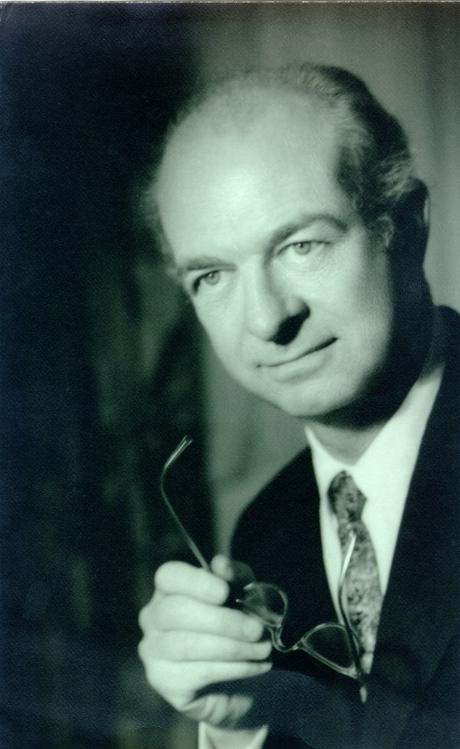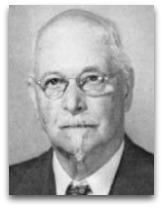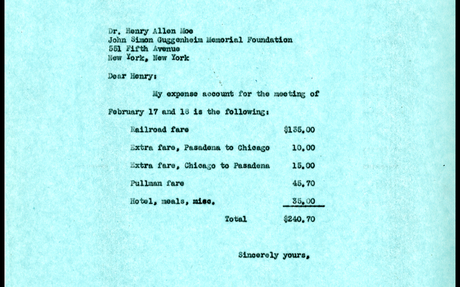 Linus Pauling, 1940s
Linus Pauling, 1940sPauling and the Guggenheim Foundation
In early 1940, Linus Pauling began the first of his twelve years on the John Simon Guggenheim Memorial Foundation’s Committee of Selection. As would become common practice, Pauling prepared for the committee’s two meetings by reading digests of fellowship applications compiled by the Foundation’s Secretary, Henry Allen Moe, and sent in mid-January.
In acknowledging his receipt of the materials, Pauling wrote to Moe that he expected this work to be “a great experience.” It took Pauling about two weeks to review all of the content and, once done, he penned another note to express his appreciation to Moe for winnowing down the submissions into something more manageable. He added as well that he was looking forward to his first Committee of Selection meeting.
In addition to Pauling, the Guggenheim Selection Committee consisted of four other members. Frank Aydelotte, the president of Swarthmore College, was its chair. He was joined by Marjorie Nicholson (literary scholar and Smith College professor), Florence Sabin (chair of the Department of Cellular Studies at the Rockefeller Institute for Medical Research), and Edwin Bidwell Wilson (mathematician at the Harvard School of Public Health). Moe also participated in the meetings.
The Committee was afforded two days to go through their first round of selections and reach consensus on who would be 1) approved, 2) deferred until the next month’s meeting, or 3) denied. A total of $150,000 was on offer for the 1940-1941 application window.
As would be the case many times in the future, Pauling took the train from Pasadena to New York, with the expectation that it would arrive on time. His plans came together nicely for the 1940 meeting — he arrived, as scheduled, on the morning of February 17, just hours before the meeting began.

Judging from the minutes of the first meeting, it is apparent that Pauling was eager to share his opinion on applicants in several areas. While Moe had encouraged Pauling to read the applications for group mathematics, Wilson was the head referee, and in once instance Wilson thought that Raymond Wilder of the University of Michigan, despite being only an “A-minus mathematician,” had made a good case for a fellowship. Pauling believed otherwise, mostly because of his feeling that Fellowships ought to be given to early career scholars and Wilder was 44 years old. Regardless, the others agreed that Wilder should receive support and he was awarded $2,500 for twelve months of “topological research on the theory of local connected spaces and generalized manifolds.”
This was not the only instance in which Pauling put forth a contrarian point of view. Another case pit Jesse Douglas, who was 43 and about to finish his tenure at the Institute for Advanced Study, against Aurel Wintner, a 37-year-old from Johns Hopkins. When head referee Wilson judged Douglas to be more able than Wintner, Pauling countered that his Caltech colleague, mathematician E. T. Bell, had confided the opposite.
Once more, age was also playing a role for Pauling, who objected to giving a Fellowship to “tide over an eminent scholar, forty-three years old” until he got a new position. For Pauling, the notion that Douglas would even be using the funds for his own “development” was in question. Committee chair Aydelotte responded to Pauling’s argument by reminding him that oftentimes the fellowships were intended to support activities outside of individual development.
Despite the back and forth, both applicants were ultimately funded: Wintner was awarded $2,000 over eight months to work with Norbert Wiener on a book on the mathematical theory of probability and statistics, and Douglas received $2,000 for twelve months to apply mathematical analysis and geometry to physics.
Pauling’s perspectives carried more weight in evaluating physics applications. In one instance, he successfully persuaded the committee to deny funding to Richard A. Beth of Worcester Polytechnic Institute. In this he had the backing of referee Arthur Compton, who thought Beth a good physicist but felt that his project showed little promise. Pauling, with the help of Caltech physicist Jesse DuMond, also looked into Beth and concluded that he was “not a coming man,” as it had evidently taken him two years to complete a project similar to that which DuMond himself had finished in three days.
In Pauling’s lead fields of chemistry, physical chemistry, and biochemistry there was less disagreement. Only one application, submitted by Arthur C. Cope, was approved in the chemistry classification; a $2,500 award for a twelve-month study of tautomerism and the chemistry of tautomeric systems. Aristid von Grosse in physical chemistry was approved (and renewed the following year) for work on products of uranium, protactinium, and thorium bombarded with neutrons. In biochemistry, all agreed that John T. Edsall of Harvard Medical School be approved at $2,100 for twelve months to study the physical chemistry of amino acids, peptides, proteins, and related compounds.
Another application – David L. Drabkin on biological oxidation-reduction processes – proved a bit more complicated. While one referee, Edwin Cohn, thought Drabkin “only less excellent” than Edsall, another referee, Charles B. Lipman, believed him to be better qualified. Pauling harbored reservations as well, but more about the applicant’s proposal, which centered on working with Hugo Theorell in Sweden, a very difficult prospect with the onset of World War II. Cohn and Pauling both agreed that Drabkin could do his work in the U.S. because the equipment at the University of Chicago would be suitable. After the meeting, Moe conferred about this possibility with Thorfin R. Hogness at Chicago, and the following month the Committee approved Drabkin for $1,500 over eight months.

After the first meeting, all Committee members had the job of following up on applications that had been deferred to the group’s second meeting. For Pauling, this meant seeking out the opinions of trusted colleagues.
In one particular instance – that of botanist Harold L. Mitchell, who had received mixed reviews from the referees – Pauling conferred with Caltech plant geneticists Ernest G. Anderson and Sterling H. Emerson. Following these meetings, Pauling recommended that Mitchell’s application be denied. In his report, Pauling noted that neither Anderson nor Emerson thought Mitchell’s project would result in much of scientific value, and that they viewed Mitchell’s previous work as being “superficial and sketchy.” Pauling also pointed out that Mitchell operated his own commercial soil conducting service and suggested that “a man who is really interested in research devotes his spare time to carrying on research rather than to a commercial sideline.”
Pauling likewise consulted with geologist and paleontologist Chester Stock about L. S. Cressman, whom Pauling and one referee favored with others opposed. H. H. Vokes and Helmut De Terra’s applications were also deferred and required Pauling to consult with Stock before the next committee gathering.
Pauling’s conversations with Stock reinforced his impressions of Cressman, whom he recommended as a “very able man, cultured, and an excellent talker and writer.” (Cressman ultimately received a fellowship.) Stock likewise described Vokes as a “first-class invertebrate paleontologist” who could be up for appointment as professor at Caltech. After receiving more details about his proposal, the Committee ultimately approved Vokes for a six-month study of the stratigraphy and invertebrate paleontology of the Lebanon Mountains. Helmut De Terra’s case was not so lucky, with Pauling recommending against a fellowship that he viewed as a “stopgap.”
Each year the Committee of Selection meetings followed a similar rhythm but, over time, the money available for Fellowships increased substantially. During Pauling’s second year the group awarded $165,000 and by 1951 that number had grown to $568,000.
As time went by and the stakes increased, Pauling’s role on the committee evolved a well. While he continued to offer his opinions in areas beyond chemistry, the press of his many other responsibilities eventually forced him to both lessen this commitment and temper the comments that he offered.
